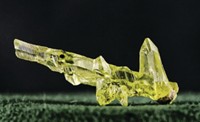Advertisement
Grab your lab coat. Let's get started
Welcome!
Welcome!
Create an account below to get 6 C&EN articles per month, receive newsletters and more - all free.
It seems this is your first time logging in online. Please enter the following information to continue.
As an ACS member you automatically get access to this site. All we need is few more details to create your reading experience.
Not you? Sign in with a different account.
Not you? Sign in with a different account.
ERROR 1
ERROR 1
ERROR 2
ERROR 2
ERROR 2
ERROR 2
ERROR 2
Password and Confirm password must match.
If you have an ACS member number, please enter it here so we can link this account to your membership. (optional)
ERROR 2
ACS values your privacy. By submitting your information, you are gaining access to C&EN and subscribing to our weekly newsletter. We use the information you provide to make your reading experience better, and we will never sell your data to third party members.
Biological Chemistry
Ancient Rocks Suggest Meteorites Brought Life’s Phosphorus To Earth
Origins of Life: Reactive phosphorus compounds eventually became part of DNA, RNA, cell membranes
by Carmen Drahl
June 7, 2013
| A version of this story appeared in
Volume 91, Issue 23

Ancient rocks from Australia have long been known to contain chemical clues about early Earth. A new look at these 3.5 billion-year-old rocks now provides a possible explanation for how the element phosphorus became a crucial part of life’s biochemistry.
Today, in its +5 oxidation state as phosphate, phosphorus powers adenosine triphosphate to energize life processes and helps form the structural backbone of DNA and RNA. However, “the origins-of-life community has struggled with the problem of how phosphate first entered into life,” says Nicholas V. Hud of Georgia Tech, who was not involved with the new study. Most phosphate on Earth is inorganic. It is insoluble in water and too inert to easily incorporate into biomolecules.
The new work, from Matthew A. Pasek of the University of South Florida and colleagues, suggests that the planet’s phosphorus makeup was once very different. The group found phosphite, with phosphorus in its +3 oxidation state, in ancient rocks. Phosphite dissolves in water and is reactive enough to be a plausible phosphorus source for proto-biomolecules (Proc. Natl. Acad. Sci. USA 2013, DOI: 10.1073/pnas.1303904110). What’s more, other scientists have found traces of early life—the outlines of primitive cells—in rocks from this region of Australia.
The find provides geochemical evidence for Pasek’s 2008 proposal that meteorites delivered reactive phosphorus to Earth in the form of a mineral called schreibersite. When dissolved in water, schreibersite releases phosphite and other reactive phosphorus species.
To test the theory that phosphorus might have made its way from schreibersite into biomolecules, Pasek’s team took a commercial reagent that mimics schreibersite and combined it with glycerol, a three-carbon alcohol also common in meteorites. After heating the material to 65 °C in water, they obtained glycerol phosphate, a cell membrane building block.
That result is intriguing, says Matthew W. Powner of University College London, who studies primeval RNA synthesis. But the reaction is quite complex, he adds, which makes it hard to verify that phosphite is responsible for adding the phosphorus to glycerol.
Pasek agrees. He says the reaction only demonstrates that schreibersite allows phosphate transfer to happen. His team plans to study the reaction mechanism and examine its scope.





Join the conversation
Contact the reporter
Submit a Letter to the Editor for publication
Engage with us on Twitter